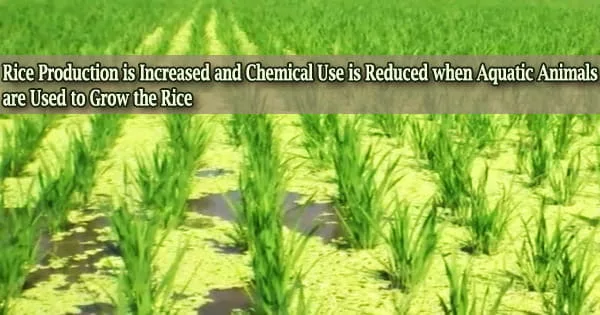According to a study published today (February 22, 2022) in eLife, growing rice with aquatic animals can eliminate the need for chemical fertilizers and pesticides while also increasing farmer yields. The findings point to a technique to assist lessen the environmental impacts of rice cultivation while also providing possible economic benefits to rice producers.
Modern farms typically grow a single crop and use a lot of fertilizers and pesticides. This has aided in crop output but at the expense of environmental deterioration.
Some farmers are experimenting with producing a combination of crops and animals in order to reduce the use of agricultural pesticides by utilizing beneficial plant-animal interactions.
“One example includes farmers experimenting with growing aquatic animals in rice paddies,” says co-first author Liang Guo, Postdoctoral Fellow at the College of Life Sciences, Zhejiang University, Hangzhou, China. “Learning more about how these animals contribute to rice paddy ecosystems could help with producing rice in a more sustainable way.”
Guo and colleagues compared the growth of rice alongside carp, mitten crabs, or softshell turtles against rice grown alone over the course of three four-year trials. They discovered that as compared to rice farmed alone, the aquatic creatures reduced weeds, enhanced organic matter decomposition, and boosted rice yields.
One example includes farmers experimenting with growing aquatic animals in rice paddies. Learning more about how these animals contribute to rice paddy ecosystems could help with producing rice in a more sustainable way.
Liang Guo
“We also saw that nitrogen levels in the soil remained steady in the rice paddies with aquatic animals, reducing the need for using nitrogen-based fertilizers,” says co-first author Lufeng Zhao, a Ph.D. student at the College of Life Sciences, Zhejiang University.
The team then looked at what the animals in the rice paddies ate. They discovered that plant and other things scavenged made up 16-50 percent of their diet, rather than their feed. They also discovered that the rice plants consumed 13-35 percent of the nitrogen from residual feed that the animals didn’t eat.
Rice planted with aquatic creatures produced yields that were 8.7% to 12.1 percent greater than rice farmed alone. Farmers were also able to raise between 0.5 and 2.5 tonnes of crabs, carp, or turtles per acre in addition to their rice.
“These results enhance our understanding of the roles of animals in agricultural ecosystems, and support the view that growing crops alongside animals has a number of benefits,” concludes Xin Chen, Professor of Ecology at the College of Life Sciences, Zhejiang University, and co-senior author of the study alongside Dr. Liangliang Hu and Professor Jianjun Tang.
“In terms of rice production, adding aquatic animals to paddies may increase farmers’ profits as they can sell both the animals and the rice, spend less on fertiliser and pesticides, and charge more for sustainably grown products.”





